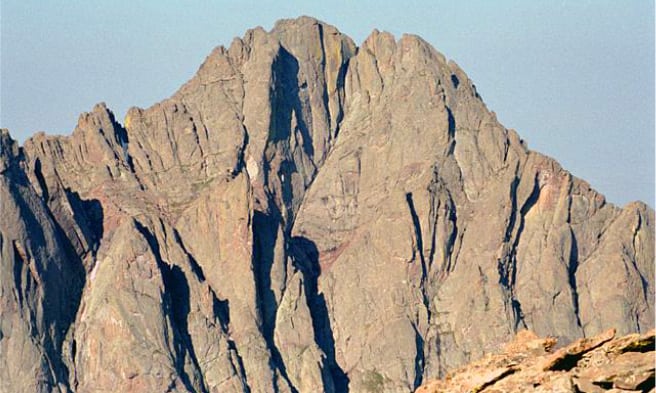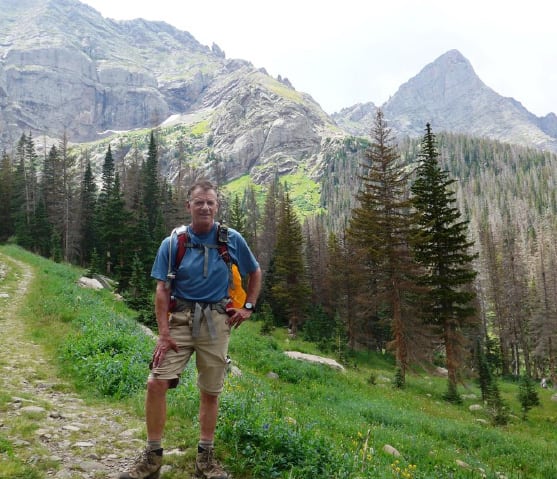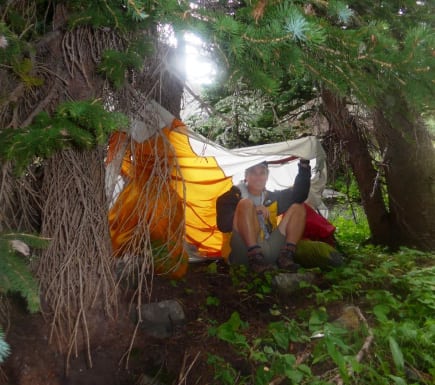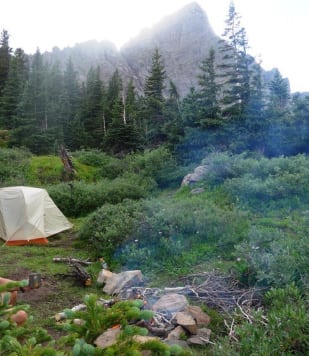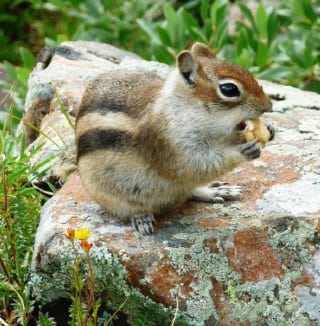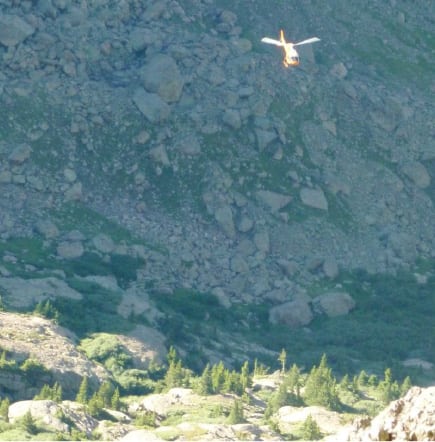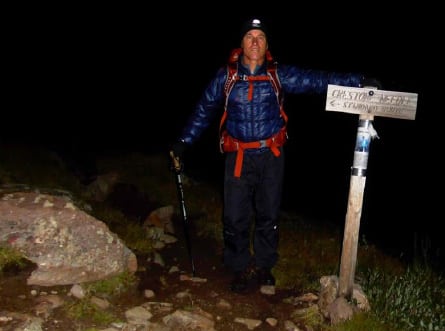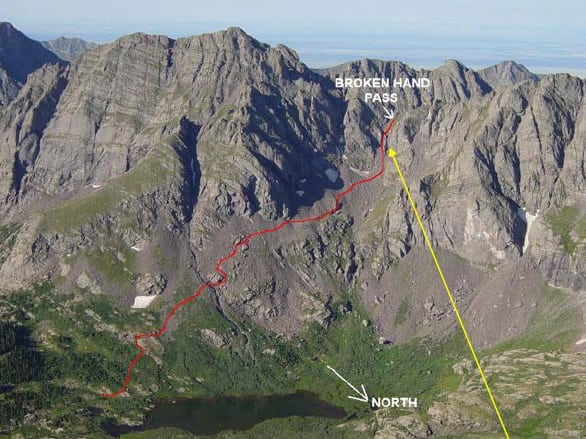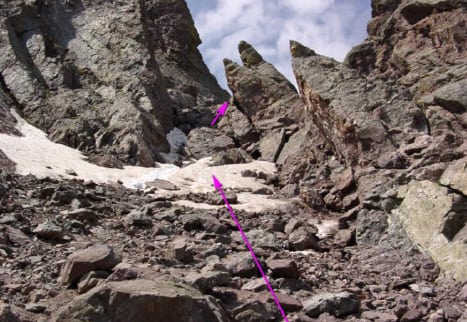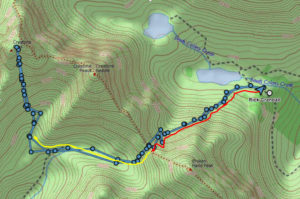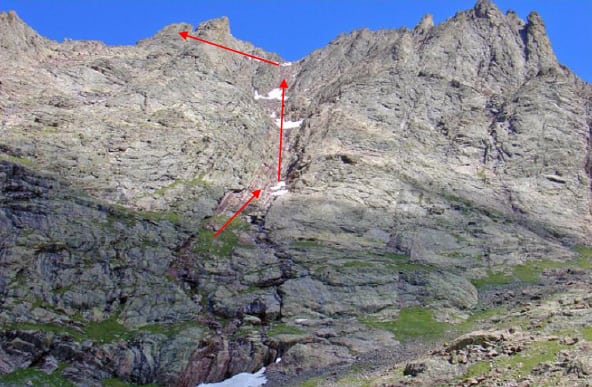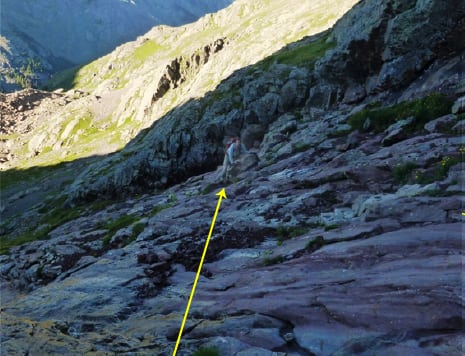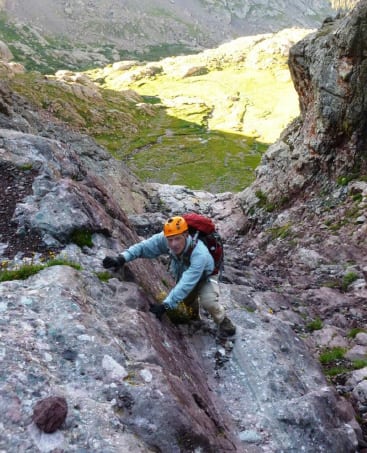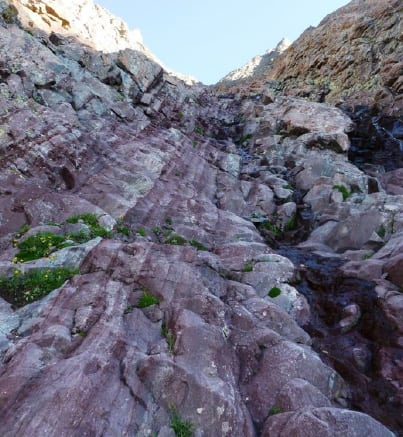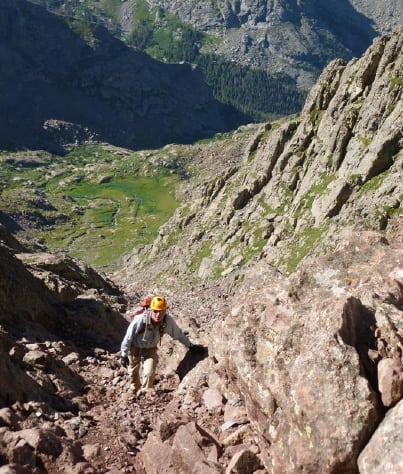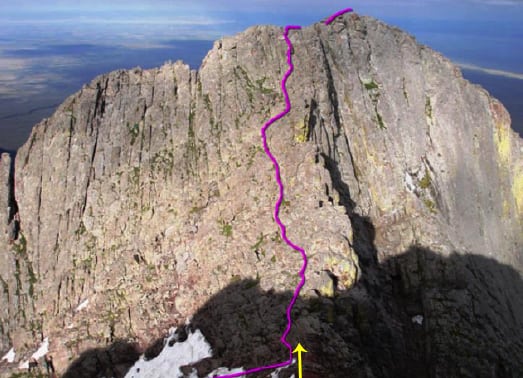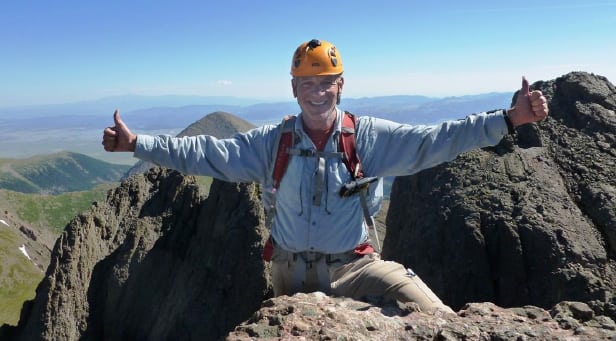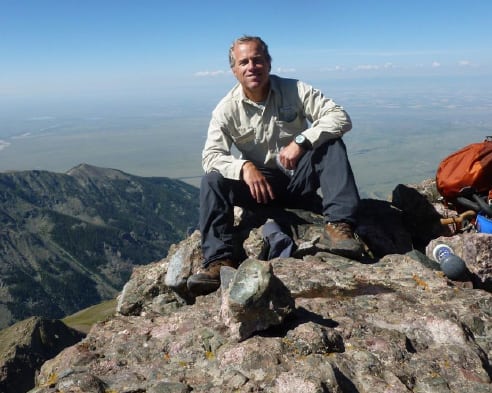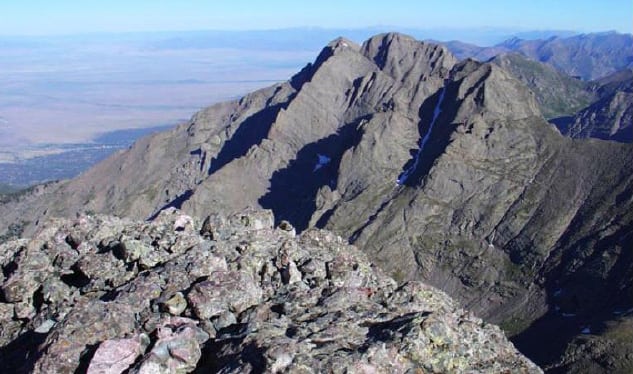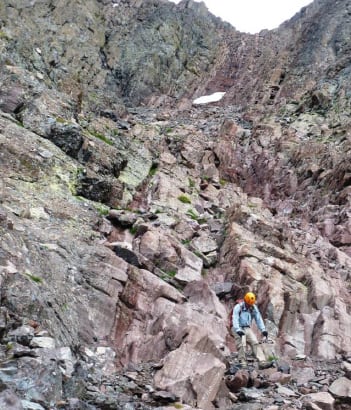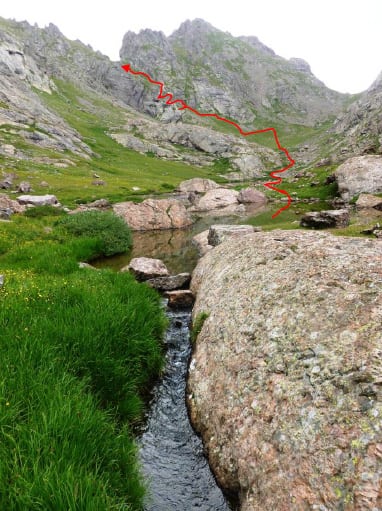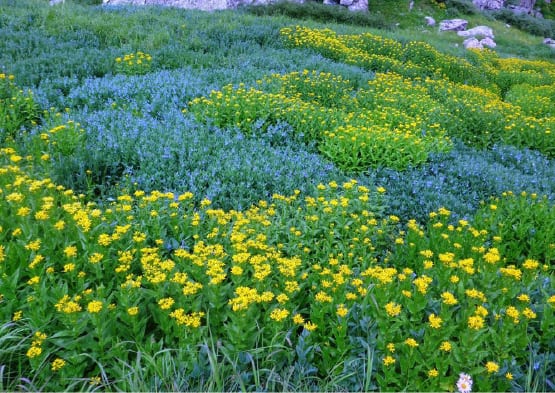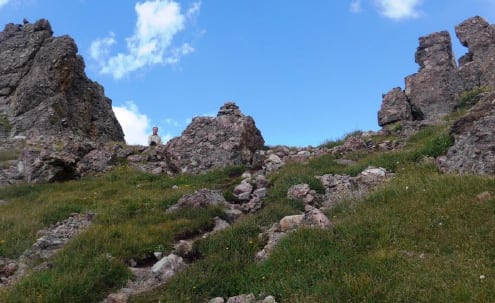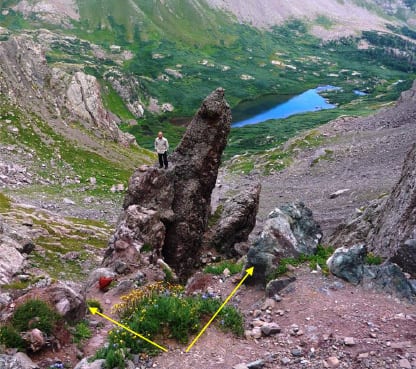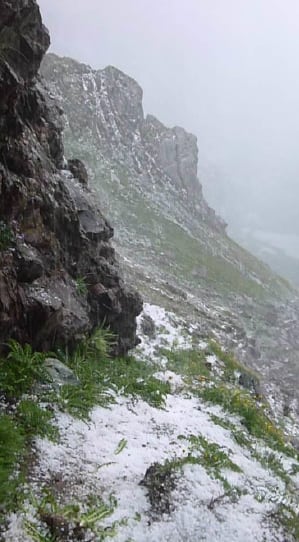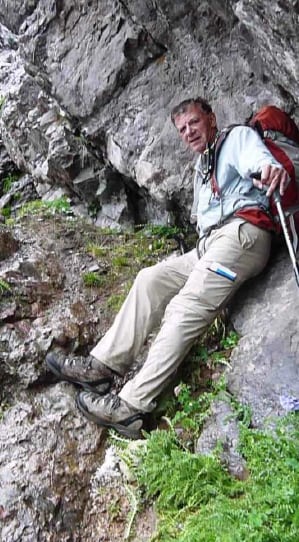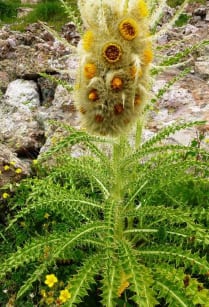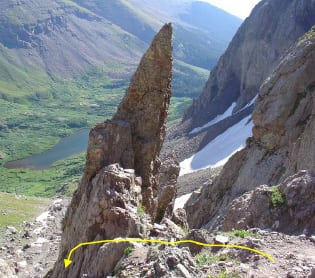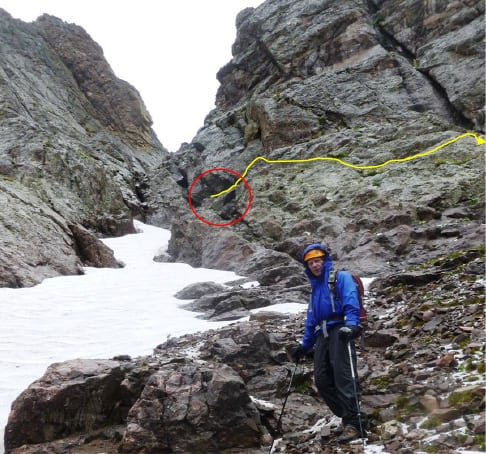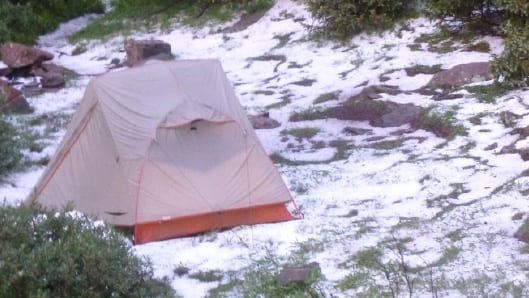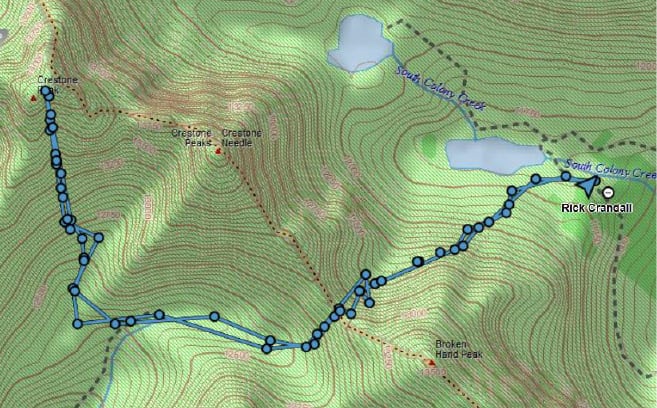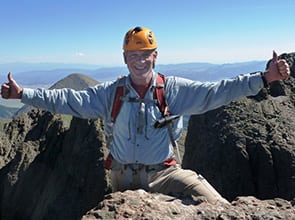
Difficulty: Class 3
Exposure: moderate +
Summit: 14,294 feet
Trailhead Elev.: 9,900 feet
Elevation Gain:
5,700 feet starting at upper 4wd TH
3,850 feet from S. Colony Lake camp
Roundtrip:
14 miles starting at upper 4wd TH (9,900’)
5 miles from S. Colony Lake camp
Climbers: Rick Crandall, Rick Peckham August 15, 2015
Crestone Peak, or “The Peak” as known among many climbers, is one of the “double-black diamond” 14ers for climbers. It is located in the Sangre de Cristo range near to the town of Crestone. It and its companion fourteener, Crestone Needle were the last of all the fourteeners to be scaled back in the 1920’s. This remote and rugged mountain was once thought impossible to climb.
The name comes from the famous “crete du coq” (cocks comb) on the Italian side of the Matterhorn which was anglicized to Crestone. (From Fourteen Thousand Feet, by John L. Jerome Hart, June, 1925)
The easiest route is not the shortest or most direct. 800 feet of elevation must be lost and regained over Broken Hand Pass, which is a 1500’ climb from the South Colony Lake, and then another 2,000 feet must be climbed up the sustained Red Couloir to the summit approach. All climbing is rated at least Class 3. Considerable climbing experience is recommended before attempting this formidable mountain.
Crestone Peak – a magnificent mountain.
We had plenty of warnings about this mountain, including from Mountain Rescue as you see in the unfolding story.
“Crestone Peak is one of the more dangerous fourteener climbs in Colorado; accidents occur often in the Crestones, some caused by falls and others by lightning (a daily summer occurrence in the Sangre de Cristos).”
From Summit Post:
Adding to the difficulty of the climb is getting there. The Crestone group of mountains is one of the more difficult to reach from any direction. Early in your research you will find a great commitment is required to claim Crestone Peak. Go prepared for a challenge and the experience of a life time!
In order to get a jump on the almost daily afternoon storms, we drove up the three-mile rough S. Colony road, parked and backpacked 4.5 miles and 1400 feet up to set camp at the South Colony Lake.
Rick C. backpacking up the closed 4WD road, nearing South Colony Lake with Crestone Needle in view on the right rear of the photo. It’s about 3:00pm, weather looks great, right?
Not so fast! Only ten minutes later a storm came up with lightening, thunder and heavy rain – seemingly out of nowhere. We found some tree cover and Rick P. pulled out his tent fly we used as a tarp.
We kept dry while we watched other hikers come by, drenched from head to toe. I guess they thought they were immune from lightning strikes. The storm was typical of the Colorado summer monsoon season, in 45 minutes it had passed and the sun came out again. We reached the Lake and found a place to set camp in view of Crestone Needle. This time the visiting animal was a big and bold chipmunk who came right up to our gear and got a piece of Rick P.’s trail mix!
While enjoying our dinner, wine, campfire and mild weather with the storm having passed, we began hearing a helicopter nearby. It flew over Broken Hand Pass – we thought towards Crestone Peak.
In the course of the next few hours we saw the chopper making 5 passes (searching?) and then was gone as dark approached.
The next morning we awoke early to get on the trail by 3:30 am. We wanted a very early start because of the extra time needed to climb Broken Hand Pass up and down to even get to the start of the real climb.
Rick P. at 3:30 am at the trail cutoff towards Broken Hand Pass. Trail markings were excellent due to the great work of the Colorado Fourteeners Initiative (CFI)– worthy of support.
Here’s the route from our campsite up to Broken Hand Pass, which we did in total darkness. Note for later in the rescue part of the story the narrow, steep chutes (vertical shadows) which are the crux of this part of the climb. The red “path” goes up on the left side of the “fin” in the middle of the gully. Also note that there’s a longer, narrow and steep gully to the right of that fin – we’ll come back to that in the rescue part of the story.
Photo of the crux of the Broken Hand Pass climb. We did this in total darkness with our headlamps on.
As we got down the other side of Broken Hand Pass and hiked into dawn around Cottonwood Lake, we were passed by two Mountain-Rescue pros. They were headed towards a down climber who was attended to by other rescuers that had been dropped from the helicopter the night before to stay with the injured climber, who we learned had a broken ankle. They asked us if we were headed to the Red Gully. “Yes,” we said. “Be careful, that gully keeps us busy. We pulled a dead guy out last week.” We ignored that unhelpful piece of info.
Here’s the total picture of the day, as recorded by my DeLorme InReach GPS tracker. Our 1500’ climb to Broken Hand Pass at 12,900’ is in red and the next stage was the 800’ down climb shown in yellow to get to the base of the Crestone Peak climb.
Here is the “Red Gully” – the longest gully climb, over 1500’, of any 14er.
Crestone Peak has two summits, each the highest point in their respective Saguache and Custer counties. The western (left) summit is 34 feet higher. At one time, there was considerable conversation as to which summit should qualify as THE top, despite the higher western summit’s elevation. However, the controversy is now over as the western summit is inarguably the highest and Custer County has it!
Rick C. heading up the Red Gully.
One of the great things about climbing is that when you get to the Class 3, 4 actual rock climbing, you’re pretty much only thinking about one thing – “what’s my next move?” The great thing about that is you are definitely in the moment, relaxed that you don’t have multiple things going on in your head – not even how to get to summit – all that matters is the next move, and then the one after that. When things get complicated with issues such as “Where’s the right route?” or “What does the weather look like?” you get anxious, but with this mountain on this day, the weather looked good and the route was basically straight up 🙂
These few shots are all taken by Rick P. who is always a few steps ahead of me in climbing speed and skill and a great eye for shots.
Now that is steep, slick rock – good that it’s solid and not loose like many gullies (that’s for further up) but it wouldn’t be much fun if wet, either up or down!
As you get further up the gully it gets looser. Helmets are definitely in order. Later on the way down, there were lots of shouts of “ROCK” from climbers above us who were not so careful – and I was ducking behind big boulders often.
Finally at the top of the gully, we get into the really fun part, the more significant Class 3 climbing to summit, and …
Celebration! Summit Crestone Peak, 14,294’ at 10:15 am, 6 ½ hours up from camp. My 50th fourteener, on August 15, 2015.
Rick P. posing with summit canister near his left foot.
The view from summit, looking at Crestone Needle – still on the “to do” list.
Another summit shot – looking northwest at tt Carson, which we did in 2013, see: https://www.rickcrandall.net/kit-carson-peak-and-challenger-point-a-long-day/
As far as we could see, the weather was still holding perfect in all directions, but it was only 10:15 in the morning. So we got our photos, ate a half of sandwich and began to head down.
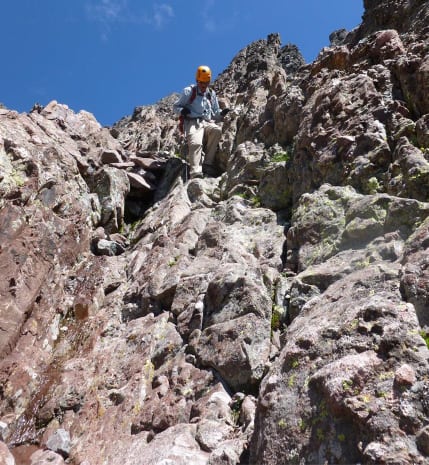
Rick C. just starting down from the summit.
As we got back to the gully, the upper part of which is very loose, our attention focused on avoiding rocks coming down from above.
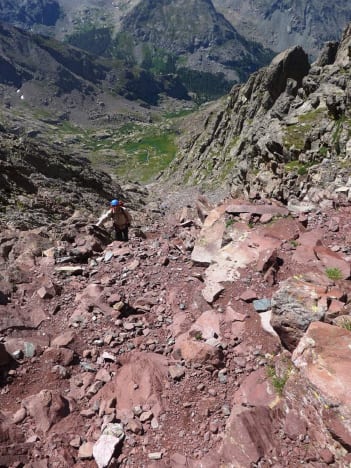
Rick P. ahead of me on the down climb: “Wow that rock was the size of a baseball and careening down.”
On the way down, the gully feels like it has no end.
Once back down to the Cottonwood Lake area, we hiked across to start the climb back up to Broken Hand Pass.
We were amazed at the beauty of the wildflowers – one of the prettiest displays we’d seen – and this is at 12,100’ in middle of August!
It was about 2:45 pm when we started the uphill to Broken Hand Pass. We were at about 12,300’ and had 600’ to go to the top. We debated whether to seek cover under some big rocks until the inevitable afternoon storm would come and pass, but we looked all around from where we could see and all looked clear, so we went for it.
Rick P. at the top of Broken Hand Pass. The ascent from this side was easy and went quickly. The sky was still blue.
We went over the top at which point we could finally see any weather issues facing toward S. Colony Lake and while there were a few clouds around we didn’t see much to be concerned with. I remembered that steep Class 3 narrow-gully area about 300’ down from the pass and I really wanted to get past that before any weather hit.
Remember early in the story my pointing out the “fin” of rock in the middle of the gully near the top of Broken Hand Pass? Well we got down to just above it and Rick P. did his usual antics by climbing on the fin itself. Note the weather was still looking great. That was at 3:40pm
Just beyond the base of that fin, on either side it got narrow, steep and with few hand-holds. We couldn’t recall which side we’d come up (it was the right side) so we picked left. While that turned out to be the more difficult side, it turned out there was a benefit. As we got to the bottom of that pitch, out of nowhere a high-impact hail and graupel storm hit with no warning and we found a small bit of overhang as cover.
At 3:55 pm, just 10 minutes later, we were socked in on a narrow strip of thistles, pelted by hail of increasing size and fury! And then the thunder and lightning show began. Hail are basically ice balls, these were the size of marbles and stung when they hit. Graupel (an Austrian term) is somewhere between hail and snow – and that was mixed in with the hail and building rapidly on the ground. This greatly complicated thoughts of climbing down from this perch.
We found a narrow ledge against the rock sidewall of the gully where it overhung and protected us from the brunt of the hail and rain, and to some extent the lightning, but it was not easy staying on it. It was tilted so we used our hiking poles to brace us up. The only thing to dig our heels into were thistles – which drilled right through our pants. In the photo, the tips of my boots were extending onto the slick, wet rock of the narrow gully – which I quickly pulled back on when a mud, snow and rock slide came careening down! We looked at each other and laughed: “What else is this mountain going to throw at us?”
As the graupel began to accumulate further, our hopes of a typical short storm faded. Rick P.’s thoughts turned to how to find a way off this ledge. My thoughts were that it was approaching 4:30, four hours away from darkness and I wanted a Plan B.
The lightning stopped, but it was still snowing. Rick P. ventured out to scout our options. He came back with the conclusion: “You’re not going to like the way down, we need to go back up.” My reaction to that? “No way, it’s hard enough when dry, now there’s snow all the way up.”
Here’s what that fin looks like in nice weather. Our route had taken us over the side to the left (yellow arrow).
The next moment another storm hit, this one even more fierce and with torrential rain. Rick P. shouted, “We’ve got to get all our layers of clothing on” which was not easy perched on an incline against the wall overhang. We got our packs off, fished out our various layers of clothing and got them on, but of course they got wet in the process. Our final layer was our rain jackets and pants but they were covering a soggy, cold mess of clothing.
Rick P. recognized that if we stayed stationary in that condition, we’d be heading towards hypothermia. He advised me, “eat food and keep your body moving in place to generate heat” which is what we did. I said, I’m calling in to mountain rescue to at least let them know we’re out here and where we are.
Rick P. got this look on his face … well first let me remind you of Rick’s background. He’s been a great friend for years, but prior to that he was in the military, and for the 14 years prior to his retirement he was Air National Guard Search and Rescue in Alaska and overseas. As he puts it, “I got to jump, dive and climb and got paid for it!” He has countless saves to his record. He’s also a paramedic and other goodies you’d want in a climbing buddy.
So I know what was going through his mind, “I RESCUE people, I don’t GET rescued.”
But those who know me – I like backup plans. So while I had an emergency GPS device I could text with, I’d heard from another climber that the cell signals were strong enough in the area, probably from the town of Crestone far below. I called 911 on my iPhone and it got through. I told the dispatcher who we were, where we were and what was going on. He asked a ton of good questions, like;
Do you have food? Water? Layers of Clothing? Rain gear? In a safe place? How much phone battery life? Etc. We had all good answers. He asked if we were calling for a rescue, I said not yet, but I wanted Mountain Rescue to know our condition and where we were – they couldn’t come then anyway due to storm conditions.
He said, “Shut your phone down to save battery. Call us back in 30 minutes to advise of changes.”
Meanwhile the lightning show that had started again, stopped but the storm intensified and looked very broad based – not just a weather cell. Rick P. went out scouting alternatives while I sat and got colder. At 5:20 I called 911 again, and dropped the flag to call for a rescue, even though it wouldn’t be possible for a while. I figured even if it got dark, if the storms broke I wanted that backup to any attempt we were going to make. Staying where we were all night was not a good option.
Minutes later at 5:20 pm I got a text from CCSARE, Custer County Search and Rescue,
CCSAR: Are you still coming off the Red Gully or are you nearing the top of Broken Hand Pass?
Rick C.: Down Broken Hand Pass part way to S. Colony Lake on right side of steep gully, but down from top. We’re trying to get to path.
CCSAR: OK you are in Custer County. Looks socked in from here. Are you stopped?
At this point Rick P. came back and said that we couldn’t wait for a rescue, it would take them at least hours and we were too wet and cold for that – and me more than him since he’d been active. All I could do was false punching in the air to create physical activity. He said to me, “I’ve gone around the corner to the drop-off, cleared the snow off, including in a chute and I made it down. I then tested the snow gully (to our right) and was able to come back up it – the snow was soft enough to kick step up so we could glissade down.”
I always hike with hiking poles that have an “L” shaped top (Leki Wanderfreunds) and have twice before used them to arrest in a glissade like a mini ice ax, so that was an option. But he decided he could protect me better down the chute and we committed to that plan. I texted to CCSAR:
Rick C.: We’ve been stopped under cliff overhang. Have layers of clothing but wet, cold. Lightening stopped but still raining. Will txt in 20 if we get off ledge.
CCSAR: Going to check Doppler. Yesterday’s storm was bad but moved out quickly. Looks like the worst is passing, but more coming. Copy, txt in 20. Where are you parked?
Rick C.: Tent at Lake, car down at upper trailhead. Going for down climb.
Rick P. then led me down a hairy chute, slowly, grabbing rock holds, some of which were underwater (streams cropping up everywhere) and soon, we were down onto more manageable terrain. The rain stopped, snow still on the rocks but we started moving and that helped warm me up. I stopped to send a text to CCSAR:
Rick C.: Down from tough spot, working toward Lake
CCSAR: OK let me know you’re down safe, we’ll stand down.
About 20 minutes later we found the main trail (and thankful again of the improvements CFI had done a few years ago), so I sent a final text:
Rick C.: On main trail, we’re good.
CCSAR: Perfect!
Rick Peckham will probably be blushing all the way back to Anchorage, but I’m here to say his commitment to our safety, his instincts in moments of possible crisis and his physical ability to almost pave the way out of a tough situation makes for a remarkable individual I’m proud to know.
We worked our way down the remaining rocky, slippery trail to the Lake. Our original plan was to pack up and hike the 4 ½ miles down to the car, but it was already 8:30pm when we got to the Lake and just before we got to camp, lightning and thunder started yet again. We decided the better plan was to get to our tents, strip off all the wet clothing and climb in our sleeping bags for warmth. We still had 1 ½ peanut butter and jelly sandwiches and a few protein bars so we were good for food.
As soon as we got to camp, even two hours after the snowfall and subsequent rain, there was still snow all around our tents all the way down at 11,800’!
Rick P. filtered some more water, heated a few cups of hot water for our warmth, and we climbed into our tents. Sleeping bags are amazing – even stripped naked its warm inside. It had been an 18-hour day and I had no problem falling asleep – although I awoke at about 2:30 am with another thunderstorm overhead.
By 3:30 am we were up. Putting our wet pants and boots back on was painful. We jammed everything else helter-skelter and soggy into our wet packs that now weighed a ton, and once again in the dark, with lights on we trudged the 4 ½ mile trek down to the car.
What a welcome sight that was. We off-roaded down the remaining 3 miles and hit a coffee shop in Westcliffe for some eggs and coffee that tasted more like caviar and champagne.
We had a lot to talk about on the ride back to Aspen – our motto has been: “Survival is good – makes for a much better story.” And that’s our story on this, my 50th fourteener climb.



